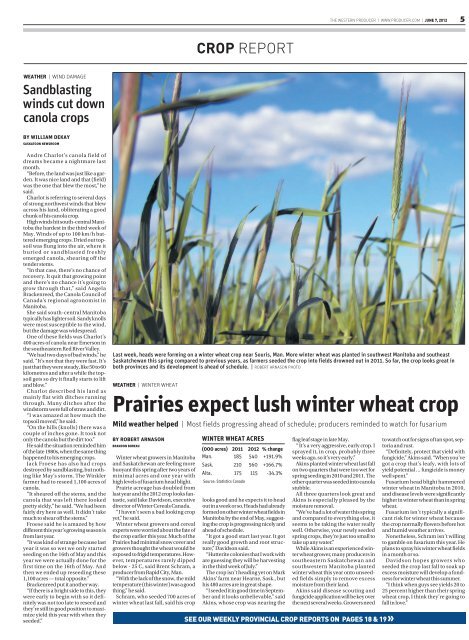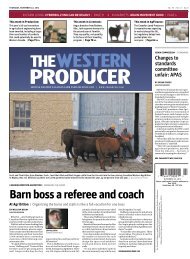CFIA tackles reforms - The Western Producer
CFIA tackles reforms - The Western Producer
CFIA tackles reforms - The Western Producer
You also want an ePaper? Increase the reach of your titles
YUMPU automatically turns print PDFs into web optimized ePapers that Google loves.
WEATHER | WIND DAMAGE<br />
Sandblasting<br />
winds cut down<br />
canola crops<br />
BY WILLIAM DEKAY<br />
SASKATOON NEWSROOM<br />
Andre Charlot’s canola field of<br />
dreams became a nightmare last<br />
month.<br />
“Before, the land was just like a garden.<br />
It was nice land and that (field)<br />
was the one that blew the most,” he<br />
said.<br />
Charlot is referring to several days<br />
of strong northwest winds that blew<br />
across his land, obliterating a good<br />
chunk of his canola crop.<br />
High winds hit south-central Manitoba<br />
the hardest in the third week of<br />
May. Winds of up to 100 km/h battered<br />
emerging crops. Dried out topsoil<br />
was flung into the air, where it<br />
buried or sandblasted freshly<br />
emerged canola, shearing off the<br />
tender stems.<br />
“In that case, there’s no chance of<br />
recovery. It quit that growing point<br />
and there’s no chance it’s going to<br />
grow through that,” said Angela<br />
Brackenreed, the Canola Council of<br />
Canada’s regional agronomist in<br />
Manitoba.<br />
She said south-central Manitoba<br />
typically has lighter soil. Sandy knolls<br />
were most susceptible to the wind,<br />
but the damage was widespread.<br />
One of these fields was Charlot’s<br />
400 acres of canola near Emerson in<br />
the southeastern Red River Valley.<br />
“We had two days of bad winds,” he<br />
said. “It’s not that they were fast. It’s<br />
just that they were steady, like 50 to 60<br />
kilometres and after a while the topsoil<br />
gets so dry it finally starts to lift<br />
and blow.”<br />
Charlot described his land as<br />
mainly flat with ditches running<br />
through. Many ditches after the<br />
windstorm were full of straw and dirt.<br />
“I was amazed at how much the<br />
topsoil moved,” he said.<br />
“On the hills (knolls) there was a<br />
couple of inches gone. It took not<br />
only the canola but the dirt too.”<br />
He said the situation reminded him<br />
of the late 1980s, when the same thing<br />
happened to his emerging crops.<br />
Jack Froese has also had crops<br />
destroyed by sandblasting, but nothing<br />
like May’s storm. <strong>The</strong> Winkler<br />
farmer had to reseed 1,100 acres of<br />
canola.<br />
“It sheared off the stems, and the<br />
canola that was left there looked<br />
pretty sickly,” he said. “We had been<br />
fairly dry here as well. It didn’t take<br />
much to shear off the stems.”<br />
Froese said he is amazed by how<br />
different this year’s growing season is<br />
from last year.<br />
“It was kind of strange because last<br />
year it was so wet we only started<br />
seeding on the 16th of May and this<br />
year we were actually done for the<br />
first time on the 16th of May. And<br />
then we ended up reseeding these<br />
1,100 acres — total opposite.”<br />
Brackenreed put it another way.<br />
“If there is a bright side to this, they<br />
were early to begin with so it definitely<br />
was not too late to reseed and<br />
they’re still in good position to maximize<br />
yield this year with when they<br />
seeded.”<br />
CROP REPORT<br />
THE WESTERN PRODUCER | WWW.PRODUCER.COM | JUNE 7, 2012<br />
Last week, heads were forming on a winter wheat crop near Souris, Man. More winter wheat was planted in southwest Manitoba and southeast<br />
Saskatchewan this spring compared to previous years, as farmers seeded the crop into fields drowned out in 2011. So far, the crop looks great in<br />
both provinces and its development is ahead of schedule. | ROBERT ARNASON PHOTO<br />
WEATHER | WINTER WHEAT<br />
Prairies expect lush winter wheat crop<br />
Mild weather helped | Most fields progressing ahead of schedule; producers reminded to watch for fusarium<br />
BY ROBERT ARNASON<br />
BRANDON BUREAU<br />
Winter wheat growers in Manitoba<br />
and Saskatchewan are feeling more<br />
buoyant this spring after two years of<br />
minimal acres and one year with<br />
high levels of fusarium head blight.<br />
Prairie acreage has doubled from<br />
last year and the 2012 crop looks fantastic,<br />
said Jake Davidson, executive<br />
director of Winter Cereals Canada.<br />
“I haven’t seen a bad looking crop<br />
yet,” he said.<br />
Winter wheat growers and cereal<br />
experts were worried about the fate of<br />
the crop earlier this year. Much of the<br />
Prairies had minimal snow cover and<br />
growers thought the wheat would be<br />
exposed to frigid temperatures. However,<br />
temperatures rarely dipped<br />
below - 25 C, said Brent Schram, a<br />
producer from Rapid City, Man.<br />
“With the lack of the snow, the mild<br />
temperature (this winter) was a good<br />
thing,” he said.<br />
Schram, who seeded 700 acres of<br />
winter wheat last fall, said his crop<br />
WINTER WHEAT ACRES<br />
(000 acres) 2011 2012 % change<br />
Man. 185 540 +191.9%<br />
Sask. 210 560 +166.7%<br />
Alta. 175 115 -34.3%<br />
Source: Statistics Canada<br />
looks good and he expects it to head<br />
out in a week or so. Heads had already<br />
formed on other winter wheat fields in<br />
Manitoba by the end of May, suggesting<br />
the crop is progressing nicely and<br />
ahead of schedule.<br />
“It got a good start last year. It got<br />
really good growth and root structure,”<br />
Davidson said.<br />
“Hutterite colonies that I work with<br />
are guessing they will be harvesting<br />
in the third week of July.”<br />
<strong>The</strong> crop isn’t heading yet on Mark<br />
Akins’ farm near Hearne, Sask., but<br />
his 480 acres are in great shape.<br />
“I seeded it in good time in September<br />
and it looks unbelievable,” said<br />
Akins, whose crop was nearing the<br />
flag leaf stage in late May.<br />
“ It’s a very aggressive, early crop. I<br />
sprayed it, in crop, probably three<br />
weeks ago, so it’s very early.”<br />
Akins planted winter wheat last fall<br />
on two quarters that were too wet for<br />
spring seeding in 2010 and 2011. <strong>The</strong><br />
other quarter was seeded into canola<br />
stubble.<br />
All three quarters look great and<br />
Akins is especially pleased by the<br />
moisture removal.<br />
“We’ve had a lot of water this spring<br />
and compared to everything else, it<br />
seems to be taking the water really<br />
well. Otherwise, your newly seeded<br />
spring crops, they’re just too small to<br />
take up any water.”<br />
While Akins is an experienced winter<br />
wheat grower, many producers in<br />
southeastern Saskatchewan and<br />
southwestern Manitoba planted<br />
winter wheat this year onto unseeded<br />
fields simply to remove excess<br />
moisture from their land.<br />
Akins said disease scouting and<br />
fungicide application will be key over<br />
the next several weeks. Growers need<br />
SEE OUR WEEKLY PROVINCIAL CROP REPORTS ON PAGES 18 & 19 »<br />
5<br />
to watch out for signs of tan spot, septoria<br />
and rust.<br />
“Definitely, protect that yield with<br />
fungicide,” Akins said. “When you’ve<br />
got a crop that’s leafy, with lots of<br />
yield potential … fungicide is money<br />
well spent.”<br />
Fusarium head blight hammered<br />
winter wheat in Manitoba in 2010,<br />
and disease levels were significantly<br />
higher in winter wheat than in spring<br />
wheat.<br />
Fusarium isn’t typically a significant<br />
risk for winter wheat because<br />
the crop normally flowers before hot<br />
and humid weather arrives.<br />
Nonetheless, Schram isn’t willing<br />
to gamble on fusarium this year. He<br />
plans to spray his winter wheat fields<br />
in a month or so.<br />
Davidson hopes growers who<br />
seeded the crop last fall to soak up<br />
excess moisture will develop a fondness<br />
for winter wheat this summer.<br />
“I think when guys see yields 20 to<br />
25 percent higher than their spring<br />
wheat crop, I think they’re going to<br />
fall in love.”








